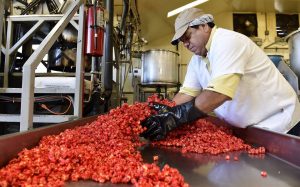Is Popcorn Cooked in Coconut Oil Healthy
May 8, 2023
 It’s been more than 120 years since Charles Cretors invented the first commercial popcorn machine. Since then, popcorn has solidified its connection to activities like going to the movies and to county fairs. Indeed, the smell of popping corn creates an instant memory of a favorite movie or event. After more than a century of public enjoyment, dieticians can move popcorn popped with coconut oil into the healthy category.
It’s been more than 120 years since Charles Cretors invented the first commercial popcorn machine. Since then, popcorn has solidified its connection to activities like going to the movies and to county fairs. Indeed, the smell of popping corn creates an instant memory of a favorite movie or event. After more than a century of public enjoyment, dieticians can move popcorn popped with coconut oil into the healthy category.
Cretos received a patent for his machine in 1893. However, heat is the only force of nature needed to pop the corn kernels, which people have known about for thousands of years. Mesoamericans popped corn kernels over heated sand. Ancient cultures like the Aztecs depended on corn (maize) for survival. Knowing the type of kernels needed for popping was a matter of skill for Aztec farmers.
Popcorn Heat and Oil Taste
Poppers using heated air hit the market in the 1970s and were heralded as a way to enjoy low-fat popcorn. The problem with air poppers is the taste. Hot air doesn’t add flavor to anything without adding something fatty to the popped corn. Air popper design meant popcorn makers had to put a stick of butter into a well that dripped butter onto the popcorn as it moved out of the popper. Although it works, air poppers can’t make movie theater popcorn because they don’t heat corn kernels with oil.
Unfortunately, movie theater popcorn doesn’t skimp on fat. How many pumps of melted butter do you take in your popcorn? The better question is, how fattening do you want your popcorn? Most commercially popped corn uses cooking oil like canola for popping corn. Popcorn isn’t popped kernels fried submerged in oil. Instead, kernels sit on a small layer of oil that goes into the kernels. If you know how much oil goes into popcorn kernels while cooking, you know that most of the oil disappears into the kernels, adding the oil’s flavor to the popped corn kernels.
Popping Corn With Coconut Oil
Charles Cretos figured out the smell of popping corn attracted people to his outdoor popcorn cart. The smell comes from the oil heating up and vaporizing into the popped kernels. You can use any oil for popcorn. However, taste matters, so coconut oil is the best choice for popping corn.
Benefits of Popcorn and Coconut Oil
All cooking oils have a flash point temperature measured in the degrees it takes to vaporize heated oil. Corn oil’s flashpoint temperature is 450 degrees Fahrenheit. Olive oil takes less heat (325 degrees Fahrenheit) before vaporizing. Coconut oil’s flash point is 350 degrees Fahrenheit, the ideal temperature for popping corn.
Butter is pure fat and provides most of the flavor. Popping with coconut oil gives the popcorn a subtle buttery and nutty taste and doesn’t require as much real butter to get the same movie theater flavor. Remember, the coconut flavor goes into the kernels, essentially replacing moisture in the kernels with vaporized and favorable oil. This is a game changer for popcorn because coconut oil has health benefits as a food supplement. Cooking corn kernels in coconut oil makes Topsy’s popcorn a healthy snack.
- There are two kinds of coconut oil, copra oil, and virgin coconut oil. The virgin variety has vitamin E and polyphenols, powerful plant antioxidants that help our bodies fight off oxidation.
- Although research is ongoing, the type of oil in coconuts is medium- and long-chain triglycerides (MCTs and LCTs). The fat in coconut oil is 65% MCTs which goes right to the liver to be metabolized into energy.
- Recent research suggests MCTs help people feel less hungry and, in the process, eat less food.
- Coconut oil fat has lauric acid, an antifungal and antimicrobial thought to help our bodies fight off staph and strep infections.
Topsy’s Popcorn is a Kansas City tradition sixty years in the making. All popcorn comes from quality kernels cooked using coconut nut oil. Visit your local Topsy’s for authentic street popcorn cooked the healthy way.
[wpu_silo links=’10’ show_thumbnails=’false’]



